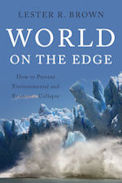Thursday, March 03, 2011
 Today’s news and opinions seem to be increasingly mixed. What is news? What is opinion? Where are the facts? The data?
Today’s news and opinions seem to be increasingly mixed. What is news? What is opinion? Where are the facts? The data?
We at the Earth Policy Institute are keenly aware of the need to back up everything we say with real data. In fact, while our books have relatively few graphs or tables, we post online all of the supporting data available for all to use.
Our newest book, World on the Edge, is a shorter book than the last three editions in the Plan B series. One might think, therefore, that we would have less data. In fact, the opposite is true. Our indefatigable research team has compiled even more data sets.
Over the next few months, we’ll be highlighting some of this data. Last week, for instance, we released our first set looking at
• gross world product,
• the number of undernourished people in the world,
• the grains price index (check out the graph that shows the recent price spike—one that is likely to climb),
• the number of high-ranking failing states,
• budgets for meeting social and earth restoration goals compared to the global military budget (a chart that should cause alarm everywhere on how much we spend for military purposes compared with the future of our planet and people),
• world energy growth rates by source (a surprising shift toward renewable energy), and
• Plan B carbon dioxide emissions goals by 2020 (it can be done; we need leadership and public support).
A few weeks ago we released a PowerPoint presentation highlighting a few of the most urgent threats to our global food supply and the trends that created them.
This week, we released a PowerPoint presentation that is basically a summary in slide version of World on the Edge. It explains the threats facing our civilization and how we got to this point, and it presents a plan for how to get out of this dangerous situation. It’s a great supplement for educators. (See our Action Center for examples of how people are using our research.)
We encourage you to view the presentations and data to gain a basic understanding of the issues at hand and how a new “Plan B” strategy can address them. We have also designed them to be shared. So please feel free to use them in your own presentations in the classroom, on the lecture circuit, and to whatever group you believe is appropriate.
Meanwhile, we are keeping track of the trends, both positive and negative, and will keep reporting on them.
Sincerely,
Reah Janise Kauffman
Vice President
Page 1 of 1 pages


